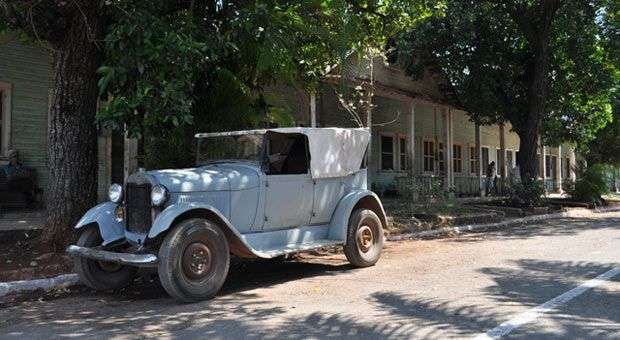I spoke the other day of Cunagua and a reader wrote to me: “I would like to know more about the batey (town built around a sugar mill). In the early sixties I did a harvest there. It was a lovely little town. Is it still cute? I never returned … “Yes, dear friend, the batey is still cute. It is, in fact, one of the most unique architectural complexes of the island. Due to its values it was declared a National Monument a few years ago, a condition that not many other places in the province of Ciego de Avila have. The batey is preserved.
Some of the typical American-inspired chalets (parquet and tiles) are in good condition. In others you can see the ravages of time and neglect. A few of them are in ruins. And some are not longer there; instead they have built ugly and sloppy masonry houses. But you can still “breathe” the spirit of the town. Yes, there is a problem, my friend, something that probably does not fit your memory: the mill doesn’t work anymore; it’s just a mass of rusted iron with a useless chimney….
You do not hear the factory whistle anymore, or the sound of the railroad cars, or the snorting of the boiler. The village is forgetting about the dirty bagasse on the laundry and heady scent of honey, and the rhythmic sound of the machines in the morning. There are no harvests in Cunagua. Or maybe I should say there are no harvests in Bolivia, which is the name they put to the mill and the town after the Revolution. The elders still call it Cunagua. But youngsters call it Bolivia.
I was in Cunagua to do a photo essay. From Violeta runs a bus three times a day. I took her by the late afternoon. Violeta (perhaps I should say Primero de Enero, but that other people around the world calls it Violeta) was in full harvest. There was a bustle, a friendly, notable activity.
When I got to Cunagua the difference hit me. Silence reigned. It was a little over three and there was hardly anyone on the streets. The houses seemed deserted, not even had people swinging on the swings of the portals. I walked the entire town, it is small.
There were blocks where I thought I was in a ghost batey. I sat on a bench in the main park. It is a big park, occupies an entire block. Three or four elders were hiding from the sun under a tree. I talked to them. All missed “the good times”. One had been a worker from the forties until well into the nineties. Another had been a machinist, or so I seemed to understand. They almost cried: “You cannot imagine the pain they caused me when they said they would close the mill for good.”
Yes I can imagine it, I was born and raised in a sugar mill. But I said nothing. I walked through the village, taking pictures. Some old women looked at me strangely. Some small children insisted that I photographed them climbing a tree. On a corner I found a very thin old man: “Take a picture of that Fotingo, is from the time of the Americans.” I did it and now I show it to you. It has a something I cannot define that I like.










